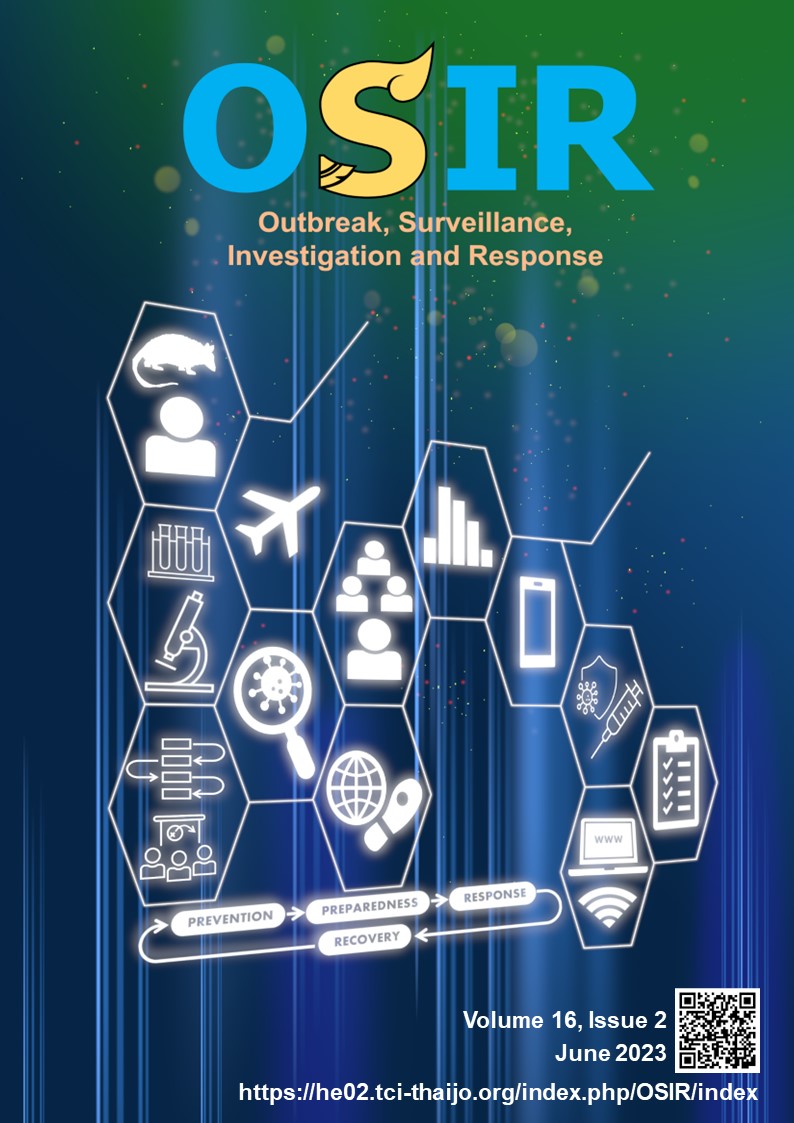Staphylococcal Food Poisoning Outbreak from a Community Gathering, Wang Nuea District, Lampang Province, Northern Thailand, July 2022
DOI:
https://doi.org/10.59096/osir.v16i2.263737Keywords:
food poisoning, outbreak investigation, Staphylococcus aureus, community-gathering, food-handlersAbstract
On 17 Jul 2022, the Thailand Department of Disease Control was notified about a food poisoning cluster related to a local funeral. We investigated to identify epidemiological characteristics of the outbreak, determine sources, and provide recommendations. A descriptive study and a retrospective cohort analysis were performed. Suspected cases were funeral participants or their household members who had at least one of the following: nausea, vomiting, abdominal pain, diarrhea, or bloody mucous stool during 17–20 Jul 2022. We used multiple logistic regression and transformed the adjusted odds ratio (AOR) to the adjusted risk ratio (ARR). We interviewed chefs and inspected the kitchen. Clinical specimens and food samples were sent for bacteria culture. Three hundred eighteen cases were identified. Ten patients (3.1%) had a shock; three had a septic shock; none died. The median age was 58 (range 47–66). The pork in the lunch boxes (ARR 7.80, 95% CI 0.75–81.34) was the most likely source. Improper food storage and cross-contamination risk were recognized. This outbreak was due to S. aureus with enterotoxin genes A and C, which were isolated from patients, food, and food handlers. Safety standards should be monitored, particularly in large community gatherings where the elderly attend.
References
World Health Organization. WHO estimates of the global burden of foodborne diseases: foodborne disease burden epidemiology reference group 2007–2015 [Internet]. Geneva: World Health Organization; 2015 [cited 2022 Oct 5]. 265 p. <https://apps.who.int/iris/bitstream/handle/10665/199350/9789241565165_eng.pdf?sequence=1>
Lee H, Yoon Y. Etiological agents implicated in foodborne illness world wide. Food Sci Anim Resour [Internet]. 2021 Jan [cited 2022 Aug 30]; 41(1):1–7. <https://doi.org/10.5851/kosfa.2020.e75>
Bureau of Epidemiology. National disease surveillance (report 506) on food poisoning 2022 [Internet]. Nonthaburi: Bureau of Epidemiology, Department of Disease Control, Ministry of Public Health (TH); 2022 [cited 2022 Aug 30]. 1 p. <http://doe.moph.go.th/surdata/506wk/y65/d03_5265.pdf>. Thai.
Division of Epidemiology, Department of Disease Control, Ministry of Publlic Health (TH). Annual epidemiological surveillance report 2019 [Internet]. Nonthaburi: Division of Epidemiology (TH); 2021 [cited 2023 Mar 7]. p. 218, 223. <https://apps-doe.moph.go.th/boeeng/download/MIX_AESR_2562.pdf>. Thai.
Division of Epidemiology, Department of Disease Control, Ministry of Publlic Health (TH). Annual epidemiological surveillance report 2020 [Internet]. Nonthaburi: Division of Epidemiology (TH); 2022 [cited 2023 Mar 7]; p. 195–6, 199. <https://apps-doe.moph.go.th/boeeng/download/AW_AESR_2563_MIX.pdf>. Thai.
Kluytmans J, van Belkum A, Verbrugh H. Nasal carriage of Staphylococcus aureus: epidemiology, underlying mechanisms, and associated risks. Clin Microbiol Rev [Internet]. 1997 Jul [cited 2023 Mar 7];10(3):505–20. < https://doi.org/10.1128/cmr.10.3.505>
Schelin J, Wallin-Carlquist N, Cohn MT, Lindqvist R, Barker GC, Radstrom P. The formation of Staphylococcus aureus enterotoxin in food environments and advances in risk assessment. Virulence [Internet]. 2011 Nov–Dec [cited 2023 Mar 7];2(6):580–92. <https://doi.org/10.4161/viru.2.6.18122>
Hennekinne JA, De Buyser ML, Dragacci S. Staphylococcus aureus and its food poisoning toxins: characterization and outbreak investigation. FEMS Microbiol Rev. 2012 Jul [cited 2023 Mar 7];36(4):815–36. <https://doi.org/10.1111/j.1574-6976.2011.00311.x>
Humphries RM, Linscott AJ. Practical guidance for clinical microbiology laboratories: Diagnosis of bacterial gastroenteritis. Clin Microbiol Rev [Internet]. 2015 [cited 2023 Mar 7];28(1):3–31. <https://doi.org/10.1111/j.1574-6976.2011.00311.x>
Adley CC, Ryan MP. The nature and extent of foodborne disease. In: Barros-Velazquez J, editor. Antimicrobial Food Packaging [Internet]. Cambridge (MA): Academic Press; 2016 Feb 5 [cited 2022 Oct 5]. p. 1–10. <https://doi.org/10.1016/B978-0-12-800723-5.00001-2>
Norton EC, Miller MM, Kleinman LC. Computing adjusted risk ratios and risk differences in Stata. Stata J [Internet]. 2013 [cited 2023 Mar 7];13(3):492–508. <https://doi.org/10.1177/1536867X1301300304>
Thaikruea L, Pataraarechachai J, Savanpunyalert P, Naluponjiragul U. An unusual outbreak of food poisoning. Southeast Asian J Trop Med Public Health [Internet]. 1995 Mar [cited 2023 Mar 7];26(1):78–85. <https://www.researchgate.net/publication/51296256_Unusual_outbreak_of_food_poisoning>
Dejburum P, Chailek C, Chuantutanon S, Na Nakhon P, Paduka N, Manakla Y, et al. An outbreak investigation of Staphylococcus aureus foodborne disease, Muang district, Satun province, Thailand during 11-12 June 2020. Weekly Epidemiological Surveillance Report [Internet]. 2021 [cited 2023 Mar 7]; 52(20):285–94. <https://wesr-doe.moph.go.th/wesr_new/file/y64/F64201_1847.pdf>
Johler S, Tichaczek-Dischinger PS, Rau J, Sihto HM, Lehner A, Adam M, et al. Outbreak of staphylococcal food poisoning due to SEA-producing Staphylococcus aureus. Foodborne Pathog Dis [Internet]. 2013 Sep [cited 2023 Mar 7];10(9):777–81. <https://doi.org/10.1089/fpd.2013.1503>
Fletcher S, Boonwaat L, Moore T, Chavada R, Conaty S. Investigating an outbreak of staphylococcal food poisoning among travellers across two Australian states. Western Pac Surveill Response J [Internet]. 2015 May 4 [cited 2023 Mar 7];6(2):17–21. doi:10.5365/WPSAR.2015.6.1.011
Pillsbury A, Chiew M, Bates J, Sheppeard V. An outbreak of staphylococcal food poisoning in a commercially catered buffet. Commun Dis Intell Q Rep [Internet]. 2013 Jun 30 [cited 2023 Mar 7];37(2):E144–8. <https://www1.health.gov.au/internet/main/publishing.nsf/Content/cda-cdi3702g.htm>
Gumbo A, Bangure D, Gombe NT, Mungati M, Tshimanga M, Hwalima Z, et al. Staphylococcus aureus food poisoning among Bulawayo City Council employees, Zimbabwe, 2014. BMC Res Notes [Internet]. 2015 [cited 2023 Mar 7];8(1):485. <https://doi.org/10.1186/s13104-015-1490-4>
World Health Organization. Five keys to safer food manual [Internet]. Geneva: WHO press ; 2006 [cited 2023 Mar 7]. 28 p. <https://apps.who.int/iris/bitstream/handle/10665/43546/9789241594639_eng.pdf>
Brillard J, Dupont CMS, Berge O, Dargaignaratz C, Oriol-Gagnier S, Doussan C, et al. The water cycle, a potential source of the bacterial pathogen Bacillus cereus. Biomed Res Int [Internet]. 2015 [cited 2023 Mar 7];2015: 356928. <http://dx.doi.org/10.1155/2015/356928>
Spinks AT, Dunstan RH, Harrison T, Coombes P, Kuczera G. Thermal inactivation of water-borne pathogenic and indicator bacteria at sub-boiling temperatures. Water Res [Internet]. 2006 Mar [cited 2023 Mar 7];40(6):1326–32. <https://doi.org/10.1016/j.watres.2006.01.032>
Artasensi A, Mazzotta S, Fumagalli L. Back to basics: Choosing the appropriate surface disinfectant. Antibiotics (Basel) [Internet]. 2021 May 21 [cited 2023 Mar 7];10(6):613. <https://doi.org/10.3390/antibiotics10060613>
Downloads
Published
How to Cite
Issue
Section
License
Copyright (c) 2023 Outbreak, Surveillance, Investigation & Response (OSIR) Journal

This work is licensed under a Creative Commons Attribution-NonCommercial-NoDerivatives 4.0 International License.









